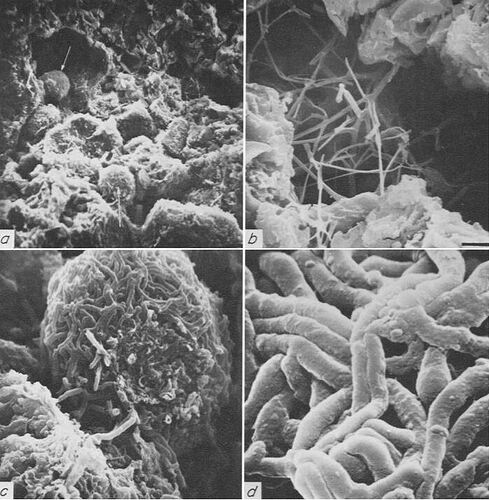I’ve become a bit obsessed with Akadama lately and would like to share some potential insights into why it is such an important component of bonsai soils. Some of this may be new info while some of it has already been discussed in the excellent resource at the link below. I am very much an amateur when it comes to bonsai, so please let me know when I am off base. Sorry for the long post. If there is interest, I could write something a little more formal describing what I’ve found in the literature.
Akadama resource from DonPettite: https://www.arcgis.com/apps/Cascade/index.html?appid=6f0b256d0201451483f224d313109010
There has been much discussion in this forum lately on the microstructure of the akadama and how it may influence the branching of fine roots. I don’t have much to add to this discussion. However, my research took a turn when I started looking for information on the primary clays of imogolite and allophane which make up the akadama. Studies on akadama in English are quite rare, but imogolite is a bit of a hot topic right now in materials research and allophanic soils have become well researched over the last 20 years. These unusual clay minerals form during the weathering of the volcanic deposits creating unique soils properties. Imogolite comes in the form of long fibrous crystals (seen in scanning electron microscope images growing like worms directly from grains of volcanic glass, see picture below from Eswaran 1972), while allophane comes in the form of hollow spherules.
More advanced weathering of the volcanic deposits results in a variety of imogolite morphologies, as illustrated in the below figure (also from Eswaran 1972), which shows dense globular clusters (a,c,d) and less tightly packed fibers (b). Eswaran (1972) identified the imogolite fibers as being on the order of .2 to .8 microns in diameter and stated that the reported nanometer-scale diameter of the fibers are possibly the result of intense sample preparation techniques utilized in TEM research that may physically alter the amalgamation properties of the imogolite. The Eswaran study utilizes basic scanning electron microscopy which typically requires little to no sample preparation beyond coating the sample with a thin conductive surface. This suggests that the real-world form of imogolite (such as in our bonsai pots) is not the nanofibers that we have previously seen but amalgamations of fibers closer to 1-micron diameter and even more likely to occur as dense clusters of fibers tens of microns in diameter.
A potentially more significant aspect of the imogolite clays is their interaction with biological materials. A recent boom in research has explored the interaction of imogolite with biological molecules. For example, imogolite has been shown to bind with DNA (see Jiravanichanun et al. 2012 figure below), resulting from the affinity of the negatively charged PO4 of the DNA to the positively charged AlOH groups on the exterior of the imogolite tubes. This interaction likely occurs with a wide variety of negatively charged functional groups on biological molecules within the bonsai pots.
Imogolite has also been shown to be an extremely efficient enzyme immobilizer, which is an inorganic substance that can bind to the enzyme and concentrate it. So, using akadama in our bonsai pots may be allowing for higher than normal amounts of biochemical activity due to the concentration of enzymes within the pot. This is in addition to the typically discussed cation exchange capacity (CEC), which details the ability of the grains to hold exchangable ions. Enzymes are proteins which allow for drastically increased biochemical activity rates (life is not possible without them). For example, the imogolite/enzyme hybrid system described by Wang On Ya et al. (2010) suggests the formation of complex gels of imogolite and an enzyme (in their case pepsin, a digestive enzyme that breaks down proteins) which may result in higher activity than the pepsin alone due to the higher concentations when bound to imogolite. The imogolite/enzyme system seems to be theoretical at this point in the literature but would likely aid in growing beneficial microbial life within the bonsai soils by capturing the important components of fertilizer and producing the conditions for high biological productivity. Essentially, utilizing akadama in a bonsai pot may be creating a sort of bioreactor with high microbial productivity.
Kazue Tazaki (very well known in geomicrobiology research) described abundant and diverse microbial colonies inhabiting imogolite gels on weathering pumice in Japan (Morikawa and Tazaki 2003; Tazaki et al. 2006). The figures below are from Tazaki et al. 2006 and show microbial cells partially and completely encased in imogolite films or gels. These papers described microbial colonies living within imgololite gels within the pumice which were covered with poorley-ordered “bio-imogolite” particles precipitating on the negatively charged structural biopolymers of the microbial cell walls. This may be the original source of the imogolite within akadama soils horizons and this process likely continues during the use of akadama as bonsai soil. However, my bias as a geomicrobioloigst may be clouding my judgment on this point. To a hammer, everything is a nail. To me, all secondary minerals have some microbial influence.
Let me if the info of this post is particularly new or helpful to any of you. I’m sure more research can provide better information if there is a desire for it. I’ve only scratched the surface of the available literature on imogolite and didn’t even look into allophane.




